1. 最佳優(yōu)先搜索(Best-First Search)
最佳優(yōu)先搜索(BFS),又稱A算法,是一種啟發(fā)式搜索算法(Heuristic Algorithm)。[不是廣度優(yōu)先搜索算法( Breadth First Search , BFS )]BFS算法在廣度優(yōu)先搜索的基礎(chǔ)上,用啟發(fā)估價函數(shù)對將要被遍歷到的點進行估價,然后選擇代價小的進行遍歷,直到找到目標節(jié)點或者遍歷完所有點,算法結(jié)束。要實現(xiàn)最佳優(yōu)先搜索我們必須使用一個優(yōu)先隊列(priority queue)來實現(xiàn),通常采用一個open優(yōu)先隊列和一個closed集,open優(yōu)先隊列用來儲存還沒有遍歷將要遍歷的節(jié)點,而closed集用來儲存已經(jīng)被遍歷過的節(jié)點。1.1 最佳優(yōu)先搜索的過程最佳優(yōu)先搜索的過程可以被描述為:1、將根節(jié)點放入優(yōu)先隊列open中。2、從優(yōu)先隊列中取出優(yōu)先級最高的節(jié)點X。3、根據(jù)節(jié)點X生成子節(jié)點Y:X的子節(jié)點Y不在open隊列或者closed中,由估價函數(shù)計算出估價值,放入open隊列中。X的子節(jié)點Y在open隊列中,且估價值優(yōu)于open隊列中的子節(jié)點Y,將open隊列中的子節(jié)點Y的估價值替換成新的估價值并按優(yōu)先值排序。X的子節(jié)點Y在closed集中,且估價值優(yōu)于closed集中的子節(jié)點Y,將closed集中的子節(jié)點Y移除,并將子節(jié)點Y加入open優(yōu)先隊列。4、將節(jié)點X放入closed集中。5、重復(fù)過程2,3,4直到目標節(jié)點找到,或者open為空,程序結(jié)束。 BFS不能保證找到一條最短路徑。然而,它比Dijkstra算法快的多,因為它用了一個啟發(fā)式函數(shù)(heuristic function)快速地導(dǎo)向目標結(jié)點。這篇博客對BFS進行了詳細的介紹用的是羅馬尼亞度假問題https://blog.csdn.net/weixin_46582817/article/details/115217489
BFS不能保證找到一條最短路徑。然而,它比Dijkstra算法快的多,因為它用了一個啟發(fā)式函數(shù)(heuristic function)快速地導(dǎo)向目標結(jié)點。這篇博客對BFS進行了詳細的介紹用的是羅馬尼亞度假問題https://blog.csdn.net/weixin_46582817/article/details/115217489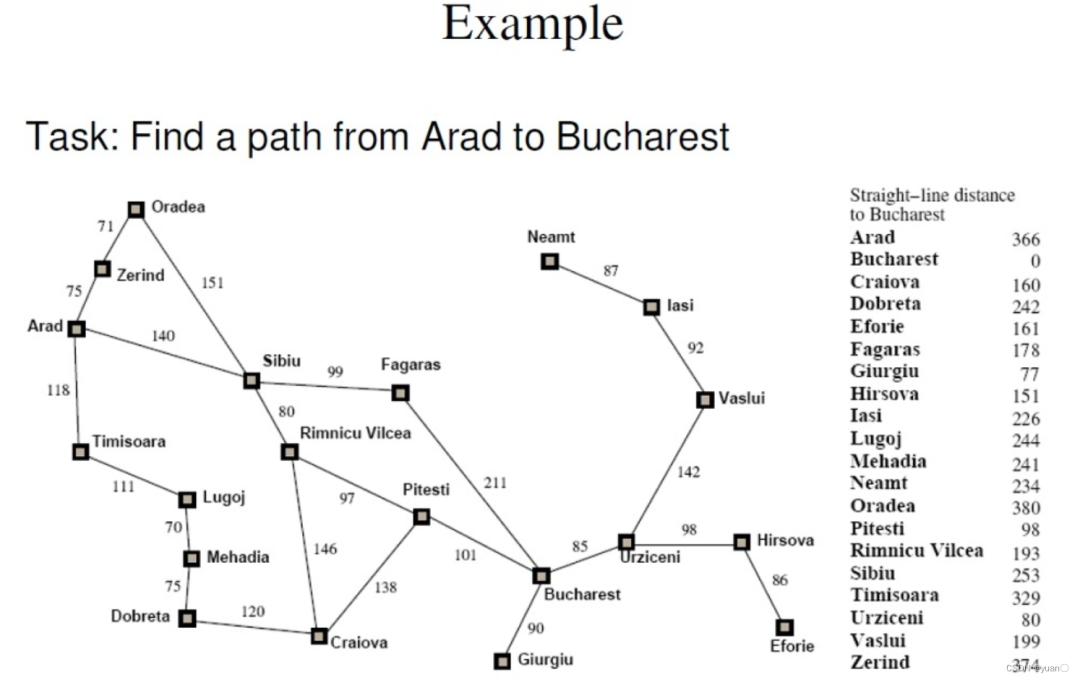 ?
?
?
?2. A-Star算法
1968年發(fā)明的A*算法就是把啟發(fā)式方法(heuristic approaches)如BFS,和常規(guī)方如Dijsktra算法結(jié)合在一起的算法。A-Star算法是一種靜態(tài)路網(wǎng)中求解最短路徑最有效的直接搜索方法,也是解決許多搜索問題的有效算法。?和Dijkstra一樣,A*能用于搜索最短路徑。?和BFS一樣,A*能用啟發(fā)式函數(shù)引導(dǎo)它自己。左圖為Astar算法效果圖,右圖為Dijkstra算法效果圖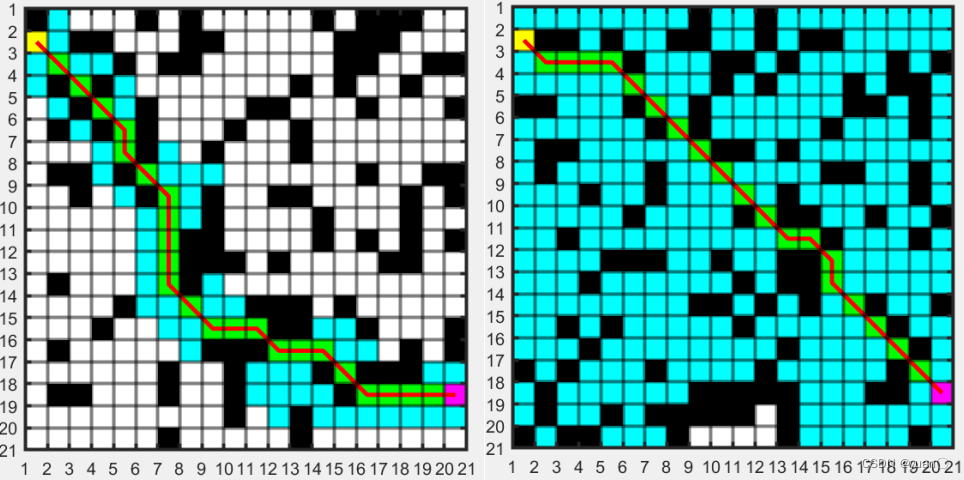 Astar算法與Dijkstra算法的效果差不多,但Astar算法訪問的節(jié)點數(shù)明顯比Dijkstra算法少得多,說明其速度更快,運行時間更短。
2.1 Astar算法所屬分類
A*算法在最短路徑搜索算法中分類為:?直接搜索算法:直接在實際地圖上進行搜索,不經(jīng)過任何預(yù)處理;?啟發(fā)式算法:通過啟發(fā)函數(shù)引導(dǎo)算法的搜索方向;?靜態(tài)圖搜索算法:被搜索的圖的權(quán)值不隨時間變化(后被證明同樣可以適用于動態(tài)圖的搜索 )
2.2 Astar算法基本概念
A*算法啟發(fā)函數(shù)表示為:f(n)=g(n)+h(n)?f(n) 是從初始狀態(tài)經(jīng)由狀態(tài)n到目標狀態(tài)的代價估計?g(n) 是在狀態(tài)空間中從初始狀態(tài)到狀態(tài)n的實際代價?h(n) 是從狀態(tài)n到目標狀態(tài)的最佳路徑的估計代價(對于路徑搜索問題,狀態(tài)就是圖中的節(jié)點,代價就是距離)Astar算法是啟發(fā)式搜索算法,啟發(fā)式搜索是在狀態(tài)空間中對每一個搜索的位置進行評估,得到最好的位置,再從這個位置進行搜索直到目標。這樣可以省略大量無謂的搜索路徑,提高效率。在啟發(fā)式搜索中,對位置的估價是十分重要的。采用了不同的估價可以有不同的效果。啟發(fā)函數(shù)(Heuristics Function)(估價函數(shù)):H為啟發(fā)函數(shù),也被認為是一種試探。由于在找到唯一路徑前,不確定在前面會出現(xiàn)什么障礙物,計算H的算法(例如,H可采用傳統(tǒng)的曼哈頓距離)具體根據(jù)實際場景決定父節(jié)點(parent):在路徑規(guī)劃中用于回溯的節(jié)點。搜索區(qū)域(The Search Area):前面圖中的搜索區(qū)域被劃分為了簡單的二維數(shù)組,數(shù)組每個元素對應(yīng)一個小方格,也可以將區(qū)域等分成是五角星,矩形等,通常將一個單位的中心點稱之為搜索區(qū)域節(jié)點(Node)。開放列表(Open List):將路徑規(guī)劃過程中待檢測的節(jié)點存放于Open List中。關(guān)閉列表(Close List):將路徑規(guī)劃過程中已經(jīng)檢查過的節(jié)點放在Close List。
2.3 啟發(fā)函數(shù)單調(diào)性的推導(dǎo)
單調(diào)性:單調(diào)性是Astar算法非常重要的一個性質(zhì),它決定了在用Astar算法進行路徑搜索時,一定能找到一條最優(yōu)路徑。設(shè)父節(jié)點的坐標為(x0,y0),它的任意一個子節(jié)點的坐標為(xi,yi),所以對兩者之間的h(x),就一定滿足
Astar算法與Dijkstra算法的效果差不多,但Astar算法訪問的節(jié)點數(shù)明顯比Dijkstra算法少得多,說明其速度更快,運行時間更短。
2.1 Astar算法所屬分類
A*算法在最短路徑搜索算法中分類為:?直接搜索算法:直接在實際地圖上進行搜索,不經(jīng)過任何預(yù)處理;?啟發(fā)式算法:通過啟發(fā)函數(shù)引導(dǎo)算法的搜索方向;?靜態(tài)圖搜索算法:被搜索的圖的權(quán)值不隨時間變化(后被證明同樣可以適用于動態(tài)圖的搜索 )
2.2 Astar算法基本概念
A*算法啟發(fā)函數(shù)表示為:f(n)=g(n)+h(n)?f(n) 是從初始狀態(tài)經(jīng)由狀態(tài)n到目標狀態(tài)的代價估計?g(n) 是在狀態(tài)空間中從初始狀態(tài)到狀態(tài)n的實際代價?h(n) 是從狀態(tài)n到目標狀態(tài)的最佳路徑的估計代價(對于路徑搜索問題,狀態(tài)就是圖中的節(jié)點,代價就是距離)Astar算法是啟發(fā)式搜索算法,啟發(fā)式搜索是在狀態(tài)空間中對每一個搜索的位置進行評估,得到最好的位置,再從這個位置進行搜索直到目標。這樣可以省略大量無謂的搜索路徑,提高效率。在啟發(fā)式搜索中,對位置的估價是十分重要的。采用了不同的估價可以有不同的效果。啟發(fā)函數(shù)(Heuristics Function)(估價函數(shù)):H為啟發(fā)函數(shù),也被認為是一種試探。由于在找到唯一路徑前,不確定在前面會出現(xiàn)什么障礙物,計算H的算法(例如,H可采用傳統(tǒng)的曼哈頓距離)具體根據(jù)實際場景決定父節(jié)點(parent):在路徑規(guī)劃中用于回溯的節(jié)點。搜索區(qū)域(The Search Area):前面圖中的搜索區(qū)域被劃分為了簡單的二維數(shù)組,數(shù)組每個元素對應(yīng)一個小方格,也可以將區(qū)域等分成是五角星,矩形等,通常將一個單位的中心點稱之為搜索區(qū)域節(jié)點(Node)。開放列表(Open List):將路徑規(guī)劃過程中待檢測的節(jié)點存放于Open List中。關(guān)閉列表(Close List):將路徑規(guī)劃過程中已經(jīng)檢查過的節(jié)點放在Close List。
2.3 啟發(fā)函數(shù)單調(diào)性的推導(dǎo)
單調(diào)性:單調(diào)性是Astar算法非常重要的一個性質(zhì),它決定了在用Astar算法進行路徑搜索時,一定能找到一條最優(yōu)路徑。設(shè)父節(jié)點的坐標為(x0,y0),它的任意一個子節(jié)點的坐標為(xi,yi),所以對兩者之間的h(x),就一定滿足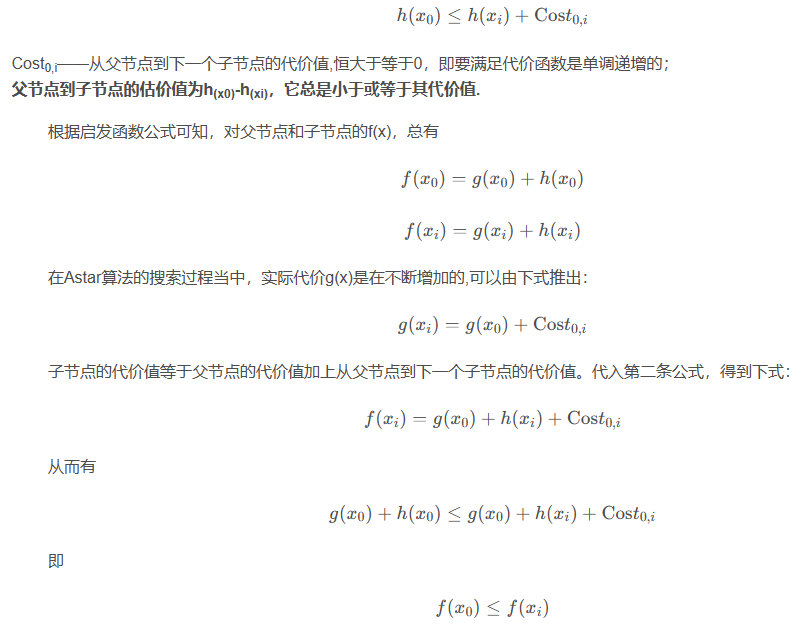 ?在Astar算法的運行過程中,后繼的f(x)值時大于當(dāng)前f(x)的值,即f(x)在之后對子節(jié)點的搜索擴展是單調(diào)遞增的,不會像人工勢場法一樣出現(xiàn)局部極小值,因此使用Astar算法規(guī)劃出的路徑一定是最優(yōu)路徑.2.4 設(shè)計代價函數(shù)時所需注意的點在使用A*算法的過程中,啟發(fā)代價的值必須盡量接近于真實值(盡量選取能取到的最大值,這樣可以提升搜索效率),以保證規(guī)劃出的路徑盡可能地與實際地圖環(huán)境相符合。根據(jù)所需的模型選擇不同的啟發(fā)代價的計算方法時,同樣必須保證啟發(fā)代價所得的估計值小于真實值。
2.5 代價函數(shù)的選擇
2.5.1 曼哈頓距離
曼哈頓距離函數(shù)在標準坐標系中,表示起始和目標兩節(jié)點的絕對值總和,其估計值就是從當(dāng)前點做水平和垂直運動,到達目標點的成本的估計,因此,曼哈頓距離函數(shù)中,兩點的距離如下
?在Astar算法的運行過程中,后繼的f(x)值時大于當(dāng)前f(x)的值,即f(x)在之后對子節(jié)點的搜索擴展是單調(diào)遞增的,不會像人工勢場法一樣出現(xiàn)局部極小值,因此使用Astar算法規(guī)劃出的路徑一定是最優(yōu)路徑.2.4 設(shè)計代價函數(shù)時所需注意的點在使用A*算法的過程中,啟發(fā)代價的值必須盡量接近于真實值(盡量選取能取到的最大值,這樣可以提升搜索效率),以保證規(guī)劃出的路徑盡可能地與實際地圖環(huán)境相符合。根據(jù)所需的模型選擇不同的啟發(fā)代價的計算方法時,同樣必須保證啟發(fā)代價所得的估計值小于真實值。
2.5 代價函數(shù)的選擇
2.5.1 曼哈頓距離
曼哈頓距離函數(shù)在標準坐標系中,表示起始和目標兩節(jié)點的絕對值總和,其估計值就是從當(dāng)前點做水平和垂直運動,到達目標點的成本的估計,因此,曼哈頓距離函數(shù)中,兩點的距離如下 K——相鄰兩節(jié)點之間的距離,即單位距離;
K——相鄰兩節(jié)點之間的距離,即單位距離;(x1,y1)——起始節(jié)點的坐標;
(x2,y2)——目標節(jié)點的坐標;
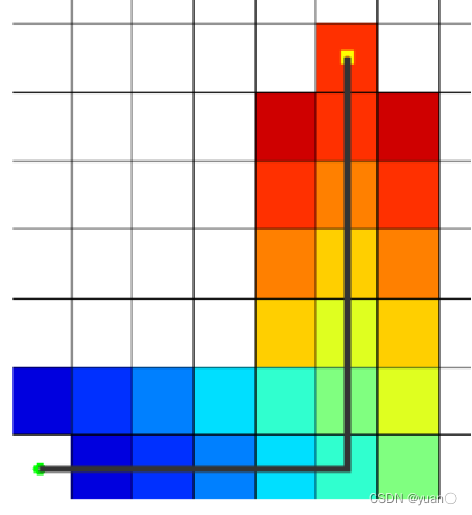 ?2.5.2 歐幾里得距離
歐幾里得距離又稱為歐式距離,它是衡量兩點之間距離遠近的最常用的方法之一。歐幾里得距離函數(shù)的值可以直接看作起始節(jié)點和目標節(jié)點,在歐式空間中的直線距離,其表達式如下所示
?2.5.2 歐幾里得距離
歐幾里得距離又稱為歐式距離,它是衡量兩點之間距離遠近的最常用的方法之一。歐幾里得距離函數(shù)的值可以直接看作起始節(jié)點和目標節(jié)點,在歐式空間中的直線距離,其表達式如下所示 K——相鄰兩節(jié)點之間的距離,即單位距離;
K——相鄰兩節(jié)點之間的距離,即單位距離;(xi,yi)——當(dāng)前節(jié)點的坐標;
(xk,yk)——目標節(jié)點的坐標;
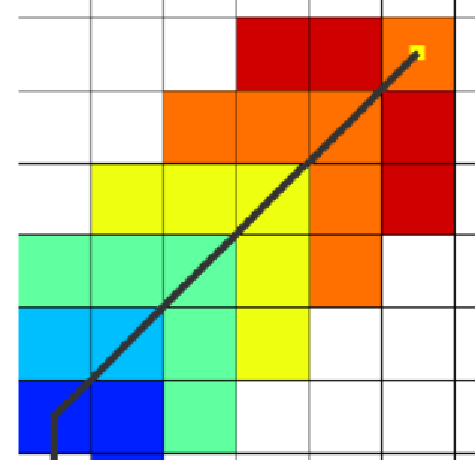 歐幾里德距離函數(shù)作為啟發(fā)代價的計算方法時,雖然尋徑時搜索空間增加從而導(dǎo)致搜索效率的降低,但其所得的估計值最小;而在使用曼哈頓距離函數(shù)時,雖然尋徑需要遍歷的柵格空間少于歐幾里得距離函數(shù),搜索效率較高,但這種方法得到的估計值與歐幾里得距離函數(shù)相比,距離真實值更遠。
2.6 確定最終路徑
已經(jīng)確定了目標節(jié)點的坐標為,根據(jù)此目標節(jié)點的位置,和先前設(shè)置的方向存儲函數(shù)之中的方向,從目標節(jié)點利用方向反推至起始節(jié)點。具體實現(xiàn)的示意圖如下
歐幾里德距離函數(shù)作為啟發(fā)代價的計算方法時,雖然尋徑時搜索空間增加從而導(dǎo)致搜索效率的降低,但其所得的估計值最小;而在使用曼哈頓距離函數(shù)時,雖然尋徑需要遍歷的柵格空間少于歐幾里得距離函數(shù),搜索效率較高,但這種方法得到的估計值與歐幾里得距離函數(shù)相比,距離真實值更遠。
2.6 確定最終路徑
已經(jīng)確定了目標節(jié)點的坐標為,根據(jù)此目標節(jié)點的位置,和先前設(shè)置的方向存儲函數(shù)之中的方向,從目標節(jié)點利用方向反推至起始節(jié)點。具體實現(xiàn)的示意圖如下
 ?2.7 路徑平滑
我們需要對規(guī)劃出的路徑進行平滑處理,將路徑的轉(zhuǎn)折處轉(zhuǎn)化為平滑的曲線,使之更加符合無人車的實際運動路徑。主要有基于B樣條曲線的路徑優(yōu)化方法,基于Dubins圓的路徑優(yōu)化方法,和基于Clothoid曲線的路徑優(yōu)化方法,基于貝塞爾曲線的路徑平滑算法。
?2.7 路徑平滑
我們需要對規(guī)劃出的路徑進行平滑處理,將路徑的轉(zhuǎn)折處轉(zhuǎn)化為平滑的曲線,使之更加符合無人車的實際運動路徑。主要有基于B樣條曲線的路徑優(yōu)化方法,基于Dubins圓的路徑優(yōu)化方法,和基于Clothoid曲線的路徑優(yōu)化方法,基于貝塞爾曲線的路徑平滑算法。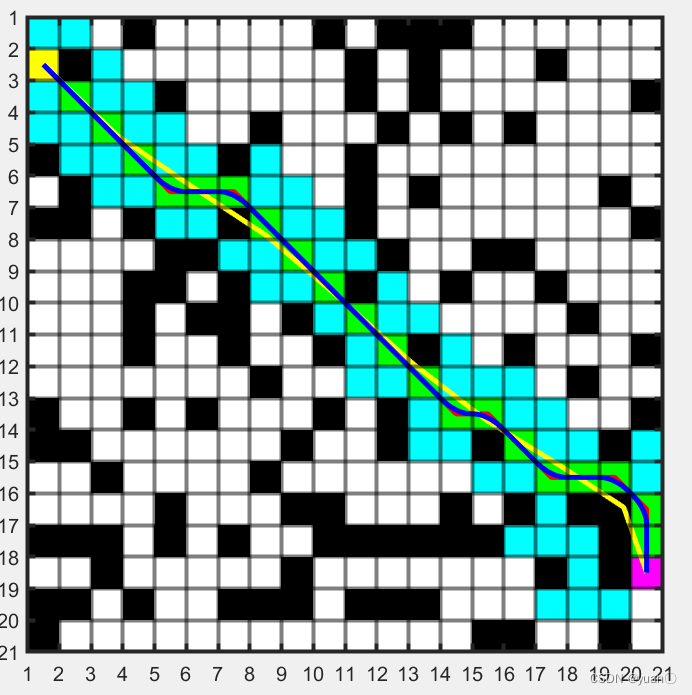 紅色為未平滑路徑,綠色方塊為最終路徑,黃色為貝塞爾曲線擬合得到,藍色為spcrv函數(shù)平滑得到。
2.8 Astar算法的優(yōu)缺點
優(yōu)點:相對于需要將所有節(jié)點展開搜尋的算法,A*算法最大的優(yōu)點就是引入了啟發(fā)信息作為向目標點移動的決策輔助,所以不再需要遍歷整個地圖,降低了計算復(fù)雜度,減少了時間損耗少。缺點:基于柵格法來分割地圖,精度越高,柵格分的就越小,就會使工作量幾何式的增長。估價函數(shù)選取的不合理也有可能導(dǎo)致無法規(guī)劃出最優(yōu)路徑。距離估計與實際值越接近,估價函數(shù)取得就越好。估價函數(shù)f(n)在g(n)一定的情況下,會或多或少的受距離估計值h(n)的制約,節(jié)點距目標點近,h值小,f值相對就小,能保證最短路的搜索向終點的方向進行,明顯優(yōu)于Dijkstra算法的毫無方向的向四周搜索。
2.9 Astar算法流程
紅色為未平滑路徑,綠色方塊為最終路徑,黃色為貝塞爾曲線擬合得到,藍色為spcrv函數(shù)平滑得到。
2.8 Astar算法的優(yōu)缺點
優(yōu)點:相對于需要將所有節(jié)點展開搜尋的算法,A*算法最大的優(yōu)點就是引入了啟發(fā)信息作為向目標點移動的決策輔助,所以不再需要遍歷整個地圖,降低了計算復(fù)雜度,減少了時間損耗少。缺點:基于柵格法來分割地圖,精度越高,柵格分的就越小,就會使工作量幾何式的增長。估價函數(shù)選取的不合理也有可能導(dǎo)致無法規(guī)劃出最優(yōu)路徑。距離估計與實際值越接近,估價函數(shù)取得就越好。估價函數(shù)f(n)在g(n)一定的情況下,會或多或少的受距離估計值h(n)的制約,節(jié)點距目標點近,h值小,f值相對就小,能保證最短路的搜索向終點的方向進行,明顯優(yōu)于Dijkstra算法的毫無方向的向四周搜索。
2.9 Astar算法流程
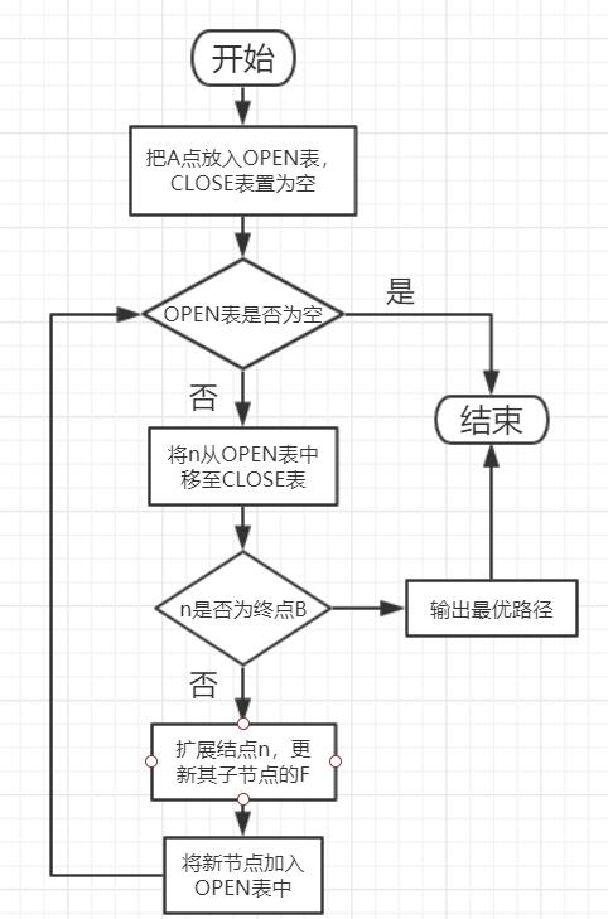 如下圖所示,綠色是起點A,紅色是終點B,一系列藍色是障礙物,從A移動到B,繞過障礙。
如下圖所示,綠色是起點A,紅色是終點B,一系列藍色是障礙物,從A移動到B,繞過障礙。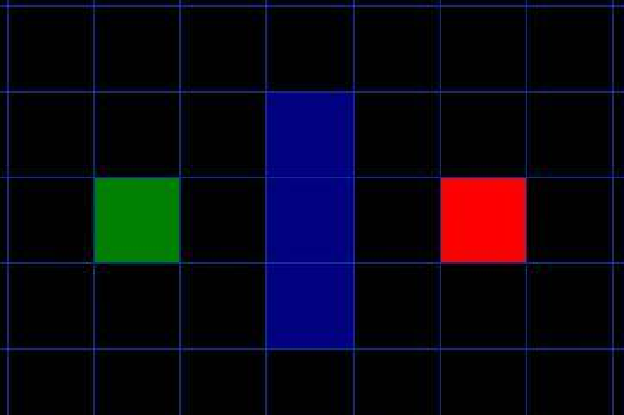 1、用方格(三角形、五角形)劃分空間,簡化搜索區(qū)域。空間被劃分為二維數(shù)組,數(shù)組中每個元素代表空間中的一個方格,可被標記為可行或不可行。未來的路徑就是一系列可行方塊的集合。Nodes的概念涵蓋了一系列可行方塊(或其它方塊)2、將起點A放到Openlist中,Openlist存放著一系列需要檢查的節(jié)點(方塊)3、給Openlist中每個節(jié)點賦值F=G+H (起點為0,橫向和縱向的移動代價為 10 ,對角線的移動代價為 14)4、檢查Openlist,選取F值最小的節(jié)點(此處為A點)。5、將A點從Openlist中刪除,放入Closelist中(Closelist中存放不可尋點,即已被訪問過的點),把A點臨近節(jié)點放入Openlist中,并將A點設(shè)為臨近節(jié)點的父節(jié)點。
1、用方格(三角形、五角形)劃分空間,簡化搜索區(qū)域。空間被劃分為二維數(shù)組,數(shù)組中每個元素代表空間中的一個方格,可被標記為可行或不可行。未來的路徑就是一系列可行方塊的集合。Nodes的概念涵蓋了一系列可行方塊(或其它方塊)2、將起點A放到Openlist中,Openlist存放著一系列需要檢查的節(jié)點(方塊)3、給Openlist中每個節(jié)點賦值F=G+H (起點為0,橫向和縱向的移動代價為 10 ,對角線的移動代價為 14)4、檢查Openlist,選取F值最小的節(jié)點(此處為A點)。5、將A點從Openlist中刪除,放入Closelist中(Closelist中存放不可尋點,即已被訪問過的點),把A點臨近節(jié)點放入Openlist中,并將A點設(shè)為臨近節(jié)點的父節(jié)點。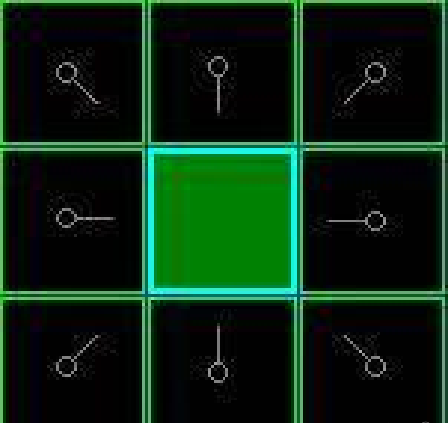 6、給Openlist中每個節(jié)點賦值,選取F值最小的節(jié)點設(shè)為當(dāng)前節(jié)點Node,(若當(dāng)前節(jié)點Node為終點,則尋路結(jié)束,若Openlist中沒有可尋節(jié)點,則尋路失敗)
6、給Openlist中每個節(jié)點賦值,選取F值最小的節(jié)點設(shè)為當(dāng)前節(jié)點Node,(若當(dāng)前節(jié)點Node為終點,則尋路結(jié)束,若Openlist中沒有可尋節(jié)點,則尋路失敗)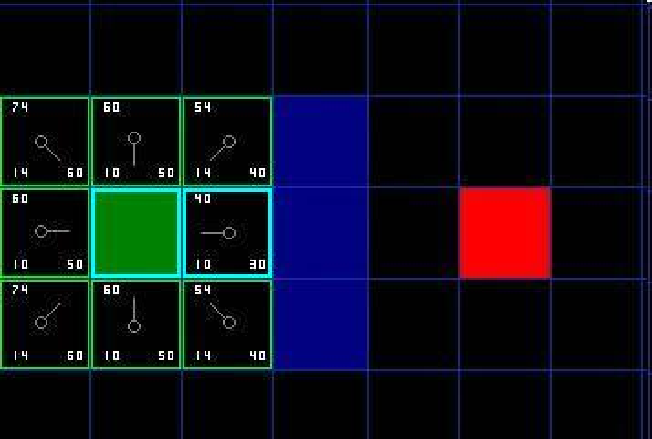 7、檢查當(dāng)前節(jié)點Node周圍臨近節(jié)點。忽略Closelist中的節(jié)點和不可行節(jié)點(障礙),如果臨近節(jié)點在Openlist中,則對比一下是否從當(dāng)前節(jié)點到臨近節(jié)點的G值比原G值(直接到臨近節(jié)點的實際代價值)小,若是,把當(dāng)前節(jié)點作為父節(jié)點。否,不做改動。如果臨近節(jié)點不在Openlist中,將其加入到Openlist中,將當(dāng)前節(jié)點設(shè)為它的父節(jié)點。8、若上步驟中新節(jié)點未造成任何改動,將新節(jié)點作為當(dāng)前節(jié)點,重復(fù)6,7)中的步驟,直到找到目標節(jié)點。
7、檢查當(dāng)前節(jié)點Node周圍臨近節(jié)點。忽略Closelist中的節(jié)點和不可行節(jié)點(障礙),如果臨近節(jié)點在Openlist中,則對比一下是否從當(dāng)前節(jié)點到臨近節(jié)點的G值比原G值(直接到臨近節(jié)點的實際代價值)小,若是,把當(dāng)前節(jié)點作為父節(jié)點。否,不做改動。如果臨近節(jié)點不在Openlist中,將其加入到Openlist中,將當(dāng)前節(jié)點設(shè)為它的父節(jié)點。8、若上步驟中新節(jié)點未造成任何改動,將新節(jié)點作為當(dāng)前節(jié)點,重復(fù)6,7)中的步驟,直到找到目標節(jié)點。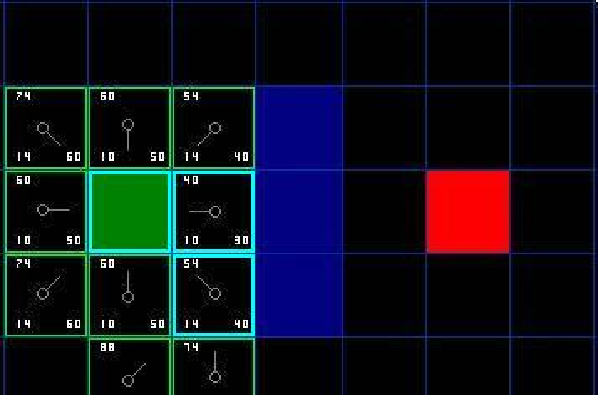 尋找到目標節(jié)點
尋找到目標節(jié)點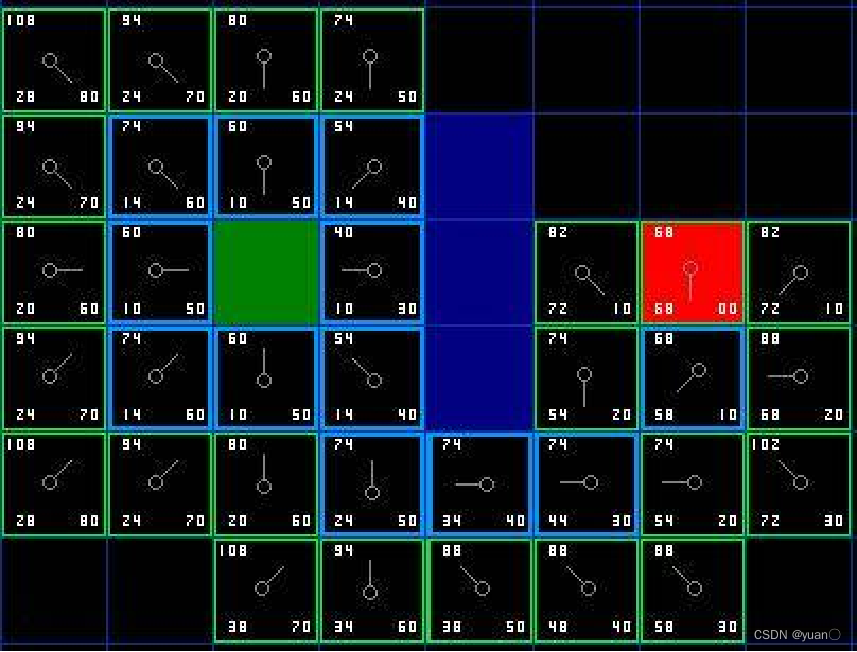 9、從目標節(jié)點回溯可以找到初始點,從而確定路徑
9、從目標節(jié)點回溯可以找到初始點,從而確定路徑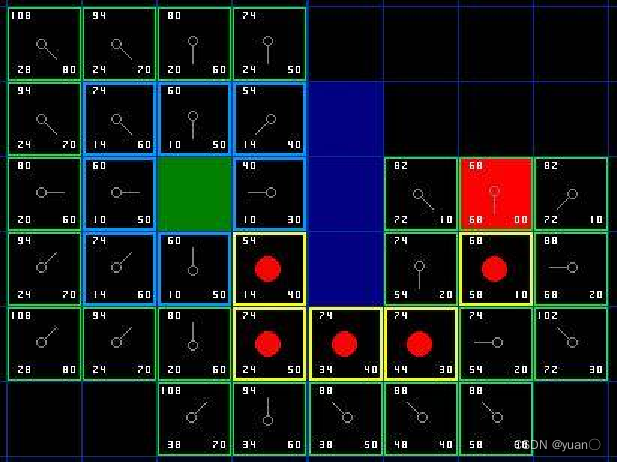 上述描述路徑的圖片有些錯誤,具體步驟如下圖所示。
上述描述路徑的圖片有些錯誤,具體步驟如下圖所示。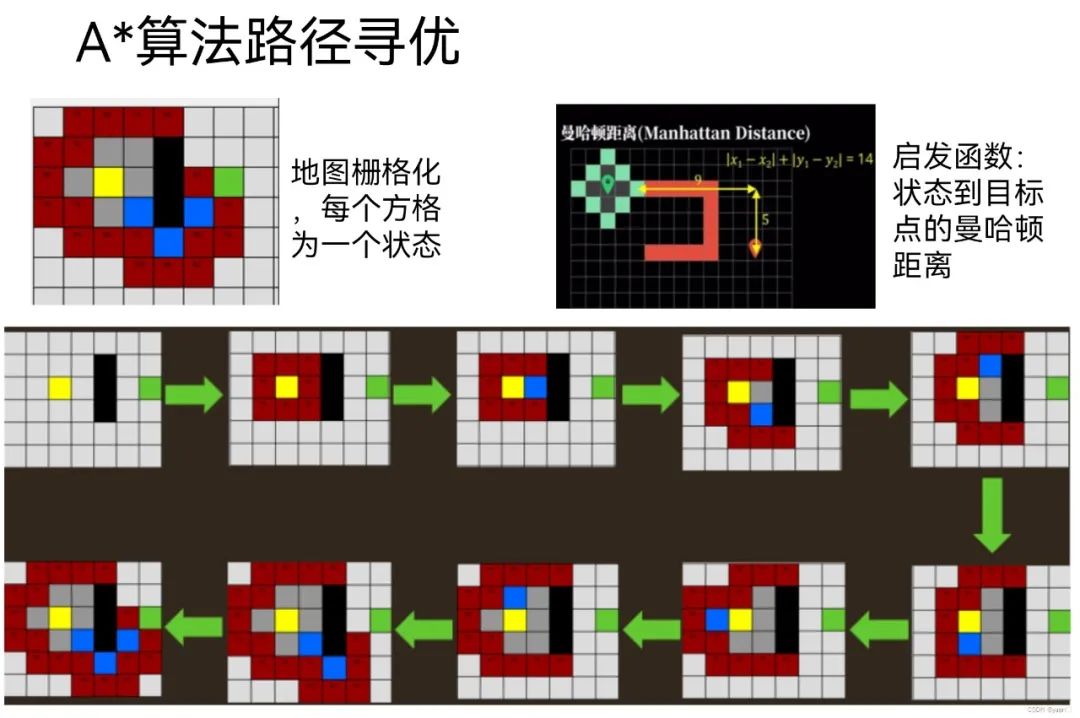 ?
?
?
?3. 其他Astar算法
3.1 Astar——三維地圖規(guī)劃 3.1.1 3D-Astar原理三維柵格地圖,顧名思義不是簡單的二維平面,它必須得有三維方向,也就是高度方向上的拓展。柵格地圖在XY水平面上的柵格的投影顏色不盡相同,柵格黃色程度越高,表明此處的高度越高。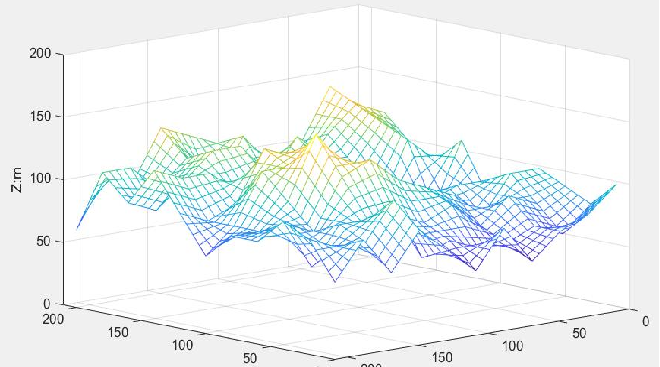 為了使啟發(fā)代價的值應(yīng)該盡量接近于真實值,三維柵格地圖中仍然選用歐幾里得距離作為估價函數(shù)計算啟發(fā)代價的計算方法。但本次實驗所處的環(huán)境為三維避障空間,因此相較于二維空間的路徑規(guī)劃,我們將公式做三維化推廣,具體形式如下:
為了使啟發(fā)代價的值應(yīng)該盡量接近于真實值,三維柵格地圖中仍然選用歐幾里得距離作為估價函數(shù)計算啟發(fā)代價的計算方法。但本次實驗所處的環(huán)境為三維避障空間,因此相較于二維空間的路徑規(guī)劃,我們將公式做三維化推廣,具體形式如下: h(n)——當(dāng)前節(jié)點到目標節(jié)點的啟發(fā)代價值;g(n-1)——當(dāng)前節(jié)點到它的父節(jié)點之間的路徑代價;D(n-1, n)——當(dāng)前節(jié)點與它的子節(jié)點之間的代價值。g(n-1)與二維規(guī)劃中的距離代價計算方法一致,但D(n-1, n)在計算時用父節(jié)點與子節(jié)點之間的距離值除以三維避障環(huán)境中設(shè)定的柵格可通行程度,h(n)也是用當(dāng)前節(jié)點到目標節(jié)點的啟發(fā)代價值除以地圖環(huán)境中預(yù)先設(shè)定的柵格可通行程度。
3.1.2 基于MATLAB實現(xiàn)3D-Astar
這里是代碼的GitHub地址:https://github.com/ybmasmiling/Astar_3D
h(n)——當(dāng)前節(jié)點到目標節(jié)點的啟發(fā)代價值;g(n-1)——當(dāng)前節(jié)點到它的父節(jié)點之間的路徑代價;D(n-1, n)——當(dāng)前節(jié)點與它的子節(jié)點之間的代價值。g(n-1)與二維規(guī)劃中的距離代價計算方法一致,但D(n-1, n)在計算時用父節(jié)點與子節(jié)點之間的距離值除以三維避障環(huán)境中設(shè)定的柵格可通行程度,h(n)也是用當(dāng)前節(jié)點到目標節(jié)點的啟發(fā)代價值除以地圖環(huán)境中預(yù)先設(shè)定的柵格可通行程度。
3.1.2 基于MATLAB實現(xiàn)3D-Astar
這里是代碼的GitHub地址:https://github.com/ybmasmiling/Astar_3D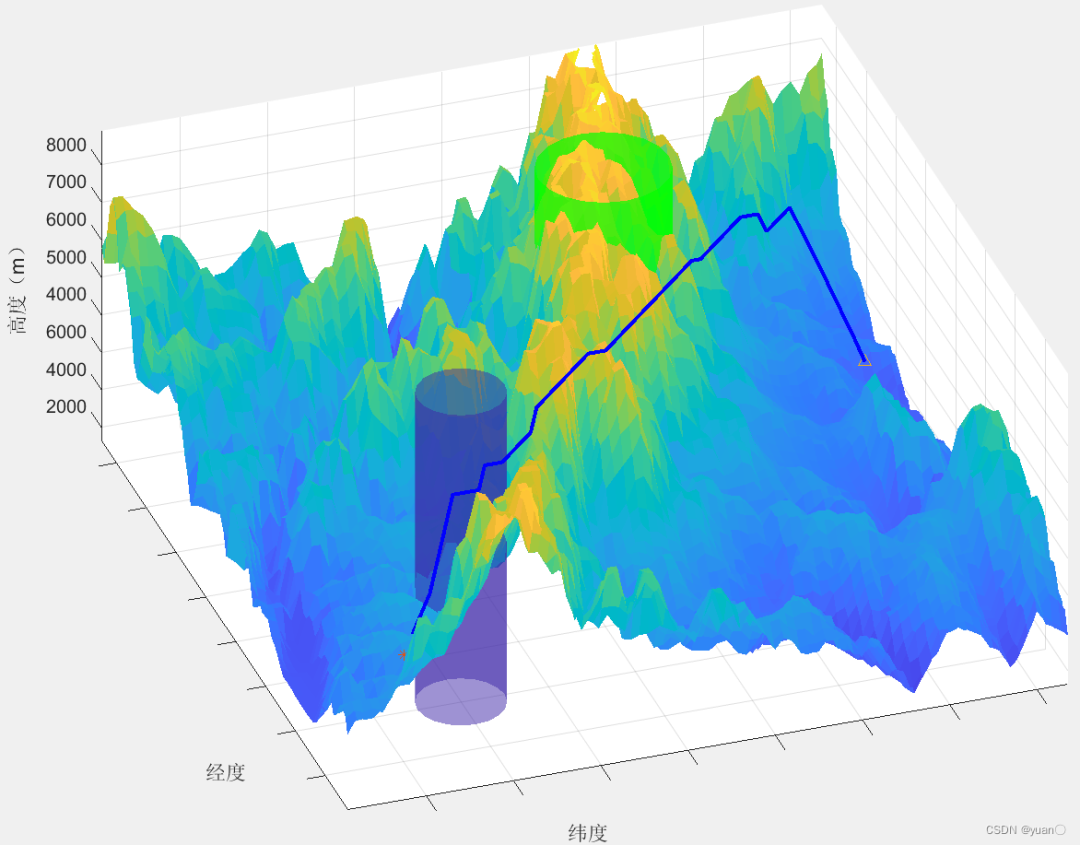
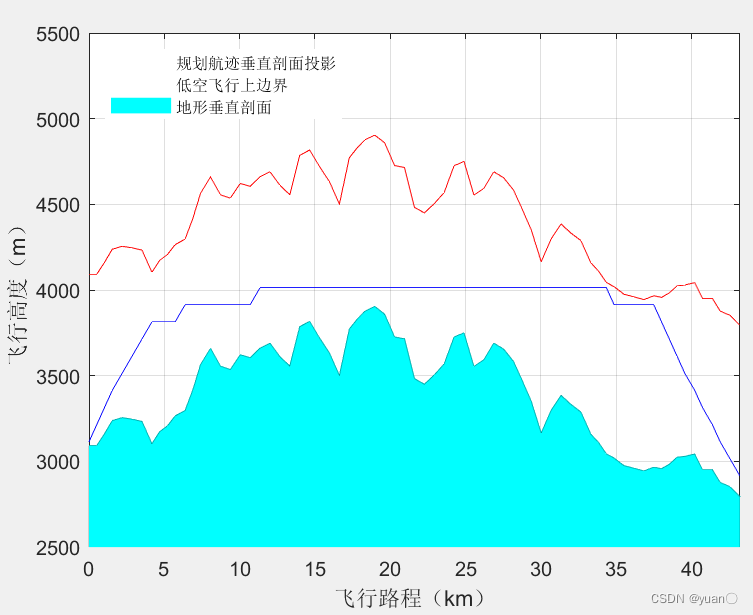 ?3.2 距離與能量復(fù)合Astar算法
經(jīng)典Astar算法路徑規(guī)劃是取兩節(jié)點間曼哈頓距離作為距離估計為最優(yōu)原則搜索路徑,從而得到最短路徑。搜索路徑的過程中并沒有考慮實際道路坡度和道路滾動阻力系數(shù)對行駛車輛最短路徑搜索的影響,也沒有考慮在道路上行駛的能量損耗問題,即經(jīng)典Astar算法搜索的最短路徑并非符合實際車輛行駛的最優(yōu)路徑。
3.2.1 最短路徑啟發(fā)函數(shù)最短路徑啟發(fā)函數(shù):
?3.2 距離與能量復(fù)合Astar算法
經(jīng)典Astar算法路徑規(guī)劃是取兩節(jié)點間曼哈頓距離作為距離估計為最優(yōu)原則搜索路徑,從而得到最短路徑。搜索路徑的過程中并沒有考慮實際道路坡度和道路滾動阻力系數(shù)對行駛車輛最短路徑搜索的影響,也沒有考慮在道路上行駛的能量損耗問題,即經(jīng)典Astar算法搜索的最短路徑并非符合實際車輛行駛的最優(yōu)路徑。
3.2.1 最短路徑啟發(fā)函數(shù)最短路徑啟發(fā)函數(shù):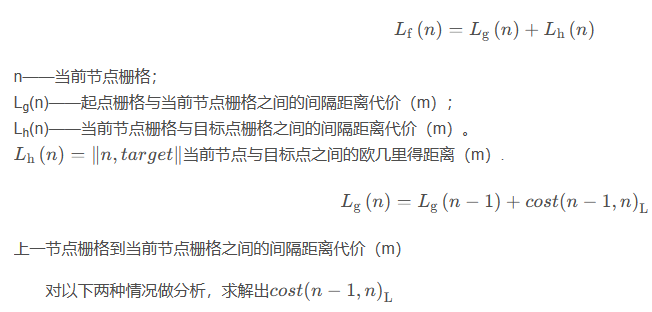
 ?最終得到的最短路徑啟發(fā)函數(shù)如下式:
?最終得到的最短路徑啟發(fā)函數(shù)如下式: ?3.2.2 最短道路損耗功啟發(fā)函數(shù)
道路損耗功啟發(fā)函數(shù):
?3.2.2 最短道路損耗功啟發(fā)函數(shù)
道路損耗功啟發(fā)函數(shù):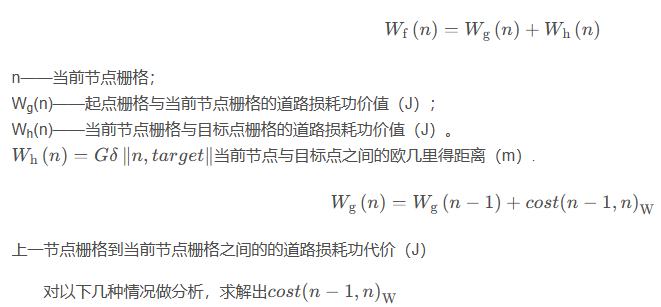
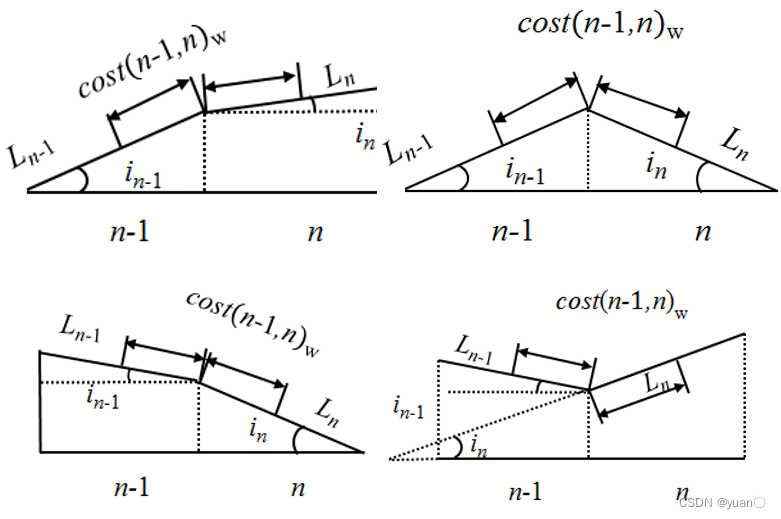 ?最終得到的最短道路損耗功啟發(fā)函數(shù)如下式:
?最終得到的最短道路損耗功啟發(fā)函數(shù)如下式: ?3.2.3 綜合啟發(fā)函數(shù)
綜合啟發(fā)函數(shù):
?3.2.3 綜合啟發(fā)函數(shù)
綜合啟發(fā)函數(shù):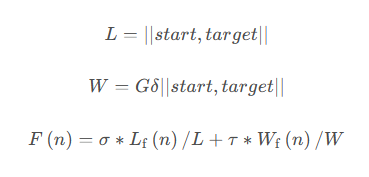
 綜合式啟發(fā)函數(shù)統(tǒng)一最短路徑啟發(fā)函數(shù)和最小道路額外功函數(shù),不同的權(quán)重大小決定最短路徑啟發(fā)函數(shù)和最小道路額外功函數(shù)在綜合式啟發(fā)函數(shù)中所占不同的比重。
3.3 雙向Astar算法
傳統(tǒng)A算法在大環(huán)境中搜索,存在著搜索效率低的問題。傳統(tǒng)A算法是從起點開始向終點搜索,直到尋到可行路徑停止搜索,在搜索路徑的前期階段遠g(n)小于h(n),搜索時橫向搜索范圍窄,縱向搜索范圍寬,搜索速度快,在搜索的后期階段g(n)遠大于h(n),搜索時縱向搜索范圍窄,橫向搜索范圍寬,搜索速度慢;**而改進后的雙向A搜索算法分別從起點和終點開始搜索,當(dāng)搜索到相同的當(dāng)前節(jié)點時,搜索結(jié)束。**相比于傳統(tǒng)A算法,雙向A*搜索算法都處于g(n)遠小于h(n)階段,一定程度上提高了算法的搜索效率,縮短搜索時間。
綜合式啟發(fā)函數(shù)統(tǒng)一最短路徑啟發(fā)函數(shù)和最小道路額外功函數(shù),不同的權(quán)重大小決定最短路徑啟發(fā)函數(shù)和最小道路額外功函數(shù)在綜合式啟發(fā)函數(shù)中所占不同的比重。
3.3 雙向Astar算法
傳統(tǒng)A算法在大環(huán)境中搜索,存在著搜索效率低的問題。傳統(tǒng)A算法是從起點開始向終點搜索,直到尋到可行路徑停止搜索,在搜索路徑的前期階段遠g(n)小于h(n),搜索時橫向搜索范圍窄,縱向搜索范圍寬,搜索速度快,在搜索的后期階段g(n)遠大于h(n),搜索時縱向搜索范圍窄,橫向搜索范圍寬,搜索速度慢;**而改進后的雙向A搜索算法分別從起點和終點開始搜索,當(dāng)搜索到相同的當(dāng)前節(jié)點時,搜索結(jié)束。**相比于傳統(tǒng)A算法,雙向A*搜索算法都處于g(n)遠小于h(n)階段,一定程度上提高了算法的搜索效率,縮短搜索時間。 ?
?
?
?4. MATLAB實現(xiàn)Astar算法
4.1 defColorMap.m 用于初始化地圖參數(shù)
function [field,cmap] = defColorMap(rows, cols)
cmap = [1 1 1; ... % 1-白色-空地
0 0 0; ... % 2-黑色-靜態(tài)障礙
1 0 0; ... % 3-紅色-動態(tài)障礙
1 1 0;... % 4-黃色-起始點
1 0 1;... % 5-品紅-目標點
0 1 0; ... % 6-綠色-到目標點的規(guī)劃路徑
0 1 1]; % 7-青色-動態(tài)規(guī)劃的路徑
% 構(gòu)建顏色MAP圖
colormap(cmap);
% 定義柵格地圖全域,并初始化空白區(qū)域
field = ones(rows, cols);
% 障礙物區(qū)域
obsRate = 0.3;
obsNum = floor(rows*cols*obsRate);
obsIndex = randi([1,rows*cols],obsNum,1);
field(obsIndex) = 2;
4.2 getChildNode.m
用于獲取子節(jié)點信息
function childNodes = getChildNode(field,closeList, parentNode)
% 選取父節(jié)點周邊8個節(jié)點作為備選子節(jié)點,線性化坐標
% 排除超過邊界之外的、位于障礙區(qū)的、位于closeList中的
[rows, cols] = size(field);
[row_parentNode, col_parentNode] = ind2sub([rows, cols], parentNode);
childNodes = [];
closeList = closeList(:,1);
% 第1個子節(jié)點(右節(jié)點)
childNode = [row_parentNode, col_parentNode+1];
if ~(childNode(1) < 1 || childNode(1) > rows ||...
childNode(2) < 1 || childNode(2) > cols)
if field(childNode(1), childNode(2)) ~= 2
childNode_LineIdx = sub2ind([rows, cols], childNode(1), childNode(2));
if ~ismember(childNode_LineIdx, closeList)
childNodes(end+1) = childNode_LineIdx;
end
end
end
% 第2個子節(jié)點(右上節(jié)點)
childNode = [row_parentNode-1, col_parentNode+1];
child_brother_node_sub1 = [row_parentNode-1, col_parentNode];
child_brother_node_sub2 = [row_parentNode, col_parentNode+1];
if ~(childNode(1) < 1 || childNode(1) > rows ||...
childNode(2) < 1 || childNode(2) > cols)
if field(childNode(1), childNode(2)) ~= 2
if ~(field(child_brother_node_sub1(1), child_brother_node_sub1(2)) == 2 & field(child_brother_node_sub2(1), child_brother_node_sub2(2)) == 2)
childNode_LineIdx = sub2ind([rows, cols], childNode(1), childNode(2));
if ~ismember(childNode_LineIdx, closeList)
childNodes(end+1) = childNode_LineIdx;
end
end
end
end
% 第3個子節(jié)點(上節(jié)點)
childNode = [row_parentNode-1, col_parentNode];
if ~(childNode(1) < 1 || childNode(1) > rows ||...
childNode(2) < 1 || childNode(2) > cols)
if field(childNode(1), childNode(2)) ~= 2
childNode_LineIdx = sub2ind([rows, cols], childNode(1), childNode(2));
if ~ismember(childNode_LineIdx, closeList)
childNodes(end+1) = childNode_LineIdx;
end
end
end
% 第4個子節(jié)點(左上)
childNode = [row_parentNode-1, col_parentNode-1];
child_brother_node_sub1 = [row_parentNode-1, col_parentNode];
child_brother_node_sub2 = [row_parentNode, col_parentNode-1];
if ~(childNode(1) < 1 || childNode(1) > rows ||...
childNode(2) < 1 || childNode(2) > cols)
if field(childNode(1), childNode(2)) ~= 2
if ~(field(child_brother_node_sub1(1), child_brother_node_sub1(2)) == 2 & field(child_brother_node_sub2(1), child_brother_node_sub2(2)) == 2)
childNode_LineIdx = sub2ind([rows, cols], childNode(1), childNode(2));
if ~ismember(childNode_LineIdx, closeList)
childNodes(end+1) = childNode_LineIdx;
end
end
end
end
% 第5個子節(jié)點(左節(jié)點)
childNode = [row_parentNode, col_parentNode-1];
if ~(childNode(1) < 1 || childNode(1) > rows ||...
childNode(2) < 1 || childNode(2) > cols)
if field(childNode(1), childNode(2)) ~= 2
childNode_LineIdx = sub2ind([rows, cols], childNode(1), childNode(2));
if ~ismember(childNode_LineIdx, closeList)
childNodes(end+1) = childNode_LineIdx;
end
end
end
% 第6個子節(jié)點(左下)
childNode = [row_parentNode+1, col_parentNode-1];
child_brother_node_sub1 = [row_parentNode, col_parentNode-1];
child_brother_node_sub2 = [row_parentNode+1, col_parentNode];
if ~(childNode(1) < 1 || childNode(1) > rows ||...
childNode(2) < 1 || childNode(2) > cols)
if field(childNode(1), childNode(2)) ~= 2
if ~(field(child_brother_node_sub1(1), child_brother_node_sub1(2)) == 2 & field(child_brother_node_sub2(1), child_brother_node_sub2(2)) == 2)
childNode_LineIdx = sub2ind([rows, cols], childNode(1), childNode(2));
if ~ismember(childNode_LineIdx, closeList)
childNodes(end+1) = childNode_LineIdx;
end
end
end
end
% 第7個子節(jié)點(下)
childNode = [row_parentNode+1, col_parentNode];
if ~(childNode(1) < 1 || childNode(1) > rows ||...
childNode(2) < 1 || childNode(2) > cols)
if field(childNode(1), childNode(2)) ~= 2
childNode_LineIdx = sub2ind([rows, cols], childNode(1), childNode(2));
if ~ismember(childNode_LineIdx, closeList)
childNodes(end+1) = childNode_LineIdx;
end
end
end
% 第8個子節(jié)點(右下)
childNode = [row_parentNode+1, col_parentNode+1];
child_brother_node_sub1 = [row_parentNode, col_parentNode+1];
child_brother_node_sub2 = [row_parentNode+1, col_parentNode];
if ~(childNode(1) < 1 || childNode(1) > rows ||...
childNode(2) < 1 || childNode(2) > cols)
if field(childNode(1), childNode(2)) ~= 2
if ~(field(child_brother_node_sub1(1), child_brother_node_sub1(2)) == 2 & field(child_brother_node_sub2(1), child_brother_node_sub2(2)) == 2)
childNode_LineIdx = sub2ind([rows, cols], childNode(1), childNode(2));
if ~ismember(childNode_LineIdx, closeList)
childNodes(end+1) = childNode_LineIdx;
end
end
end
end
4.3 Astar.m
主程序
% 基于柵格地圖的機器人路徑規(guī)劃算法
% A*算法
clc
clear
close all
%% 柵格界面、場景定義
% 行數(shù)和列數(shù)
rows = 20;
cols = 20;
[field,cmap] = defColorMap(rows, cols);
% 起點、終點、障礙物區(qū)域
startPos = 2;
goalPos = rows*cols-2;
field(startPos) = 4;
field(goalPos) = 5;
%% 預(yù)處理
% 初始化closeList
parentNode = startPos;
closeList = [startPos,0];
% 初始化openList
openList = struct;
childNodes = getChildNode(field,closeList,parentNode);
for i = 1:length(childNodes)
[row_startPos,col_startPos] = ind2sub([rows, cols],startPos);
[row_goalPos,col_goalPos] = ind2sub([rows, cols],goalPos);
[row,col] = ind2sub([rows, cols],childNodes(i));
% 存入openList結(jié)構(gòu)體
openList(i).node = childNodes(i);
openList(i).g = norm([row_startPos,col_startPos] - [row,col]); % 實際代價采用歐式距離
openList(i).h = abs(row_goalPos - row) + abs(col_goalPos - col); % 估計代價采用曼哈頓距離
openList(i).f = openList(i).g + openList(i).h;
end
% 初始化path
for i = 1:rows*cols
path{i,1} = i; % 線性索引值
end
for i = 1:length(openList)
node = openList(i).node;
path{node,2} = [startPos,node];
end
%% 開始搜索
% 從openList開始搜索移動代價最小的節(jié)點
[~, idx_min] = min([openList.f]);
parentNode = openList(idx_min).node;
% 進入循環(huán)
while true
% 找出父節(jié)點的8個子節(jié)點,障礙物節(jié)點用inf,
childNodes = getChildNode(field, closeList,parentNode);
% 判斷這些子節(jié)點是否在openList中,若在,則比較更新;沒在則追加到openList中
for i = 1:length(childNodes)
% 需要判斷的子節(jié)點
childNode = childNodes(i);
[in_flag,idx] = ismember(childNode, [openList.node]);
% 計算代價函數(shù)
[row_parentNode,col_parentNode] = ind2sub([rows, cols], parentNode);
[row_childNode,col_childNode] = ind2sub([rows, cols], childNode);
[row_goalPos,col_goalPos] = ind2sub([rows, cols],goalPos);
g = openList(idx_min).g + norm( [row_parentNode,col_parentNode] -...
[row_childNode,col_childNode]);
h = abs(row_goalPos - row_childNode) + abs(col_goalPos - col_childNode); % 采用曼哈頓距離進行代價估計
f = g + h;
if in_flag % 若在,比較更新g和f
if f < openList(idx).f
openList(idx).g = g;
openList(idx).h = h;
openList(idx).f = f;
path{childNode,2} = [path{parentNode,2}, childNode];
end
else % 若不在,追加到openList
openList(end+1).node = childNode;
openList(end).g = g;
openList(end).h = h;
openList(end).f = f;
path{childNode,2} = [path{parentNode,2}, childNode];
end
end
% 從openList移出移動代價最小的節(jié)點到closeList
closeList(end+1,: ) = [openList(idx_min).node, openList(idx_min).f];
openList(idx_min)= [];
% 重新搜索:從openList搜索移動代價最小的節(jié)點
[~, idx_min] = min([openList.f]);
parentNode = openList(idx_min).node;
% 判斷是否搜索到終點
if parentNode == goalPos
closeList(end+1,: ) = [openList(idx_min).node, openList(idx_min).f];
break
end
end
%% 畫路徑
% 找出目標最優(yōu)路徑
path_target = path{goalPos,2};
for i = 1:rows*cols
if ~isempty(path{i,2})
field((path{i,1})) = 7;
end
end
field(startPos) = 4;
field(goalPos) = 5;
field(path_target(2:end-1)) = 6;
% 畫柵格圖
image(1.5,1.5,field);
grid on;
set(gca,'gridline','-','gridcolor','k','linewidth',2,'GridAlpha',0.5);
set(gca,'xtick',1:cols+1,'ytick',1:rows+1);
axis image;
hold on;
[y0,x0] = ind2sub([rows,cols], path_target);
y = y0 + 0.5;
x = x0 + 0.5;
plot(x,y,'-','Color','r','LineWidth',2.5);
hold on;
points = [x',y'];
M = 10;
[x1,y1] = bezir_n(points, M);
plot(x1,y1,'-','Color','y','LineWidth',2.5);
hold on;
values = spcrv([[x(1) x x(end)];[y(1) y y(end)]],3);
plot(values(1,:),values(2,:),'b','LineWidth',2.5);
4.4 算法效果
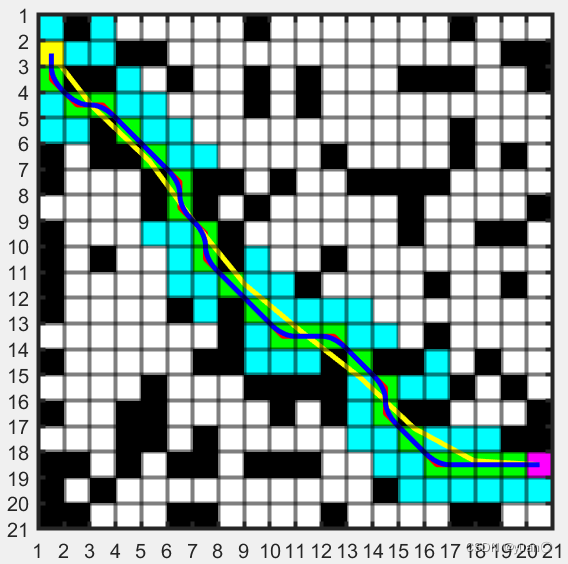 運行總時間
運行總時間 柵格地圖大小(20x20)
柵格地圖大小(20x20) 柵格地圖大小(30x30)
柵格地圖大小(30x30) 柵格地圖大小(40x40)可以看到Astar算法對于柵格地圖越大的情況,搜索時間越長,其速度相比Dijkstra有優(yōu)勢(尤其是在地圖比較大的時候,優(yōu)勢更明顯)。但其總耗時較長,不適用于實時的路徑規(guī)劃,不適用于局部路徑規(guī)劃,適用于全局路徑規(guī)劃。
柵格地圖大小(40x40)可以看到Astar算法對于柵格地圖越大的情況,搜索時間越長,其速度相比Dijkstra有優(yōu)勢(尤其是在地圖比較大的時候,優(yōu)勢更明顯)。但其總耗時較長,不適用于實時的路徑規(guī)劃,不適用于局部路徑規(guī)劃,適用于全局路徑規(guī)劃。
5. python實現(xiàn)Astar算法
可以參考這篇文章https://www.jianshu.com/p/5704e67f40aa這篇文章介紹了Astar以及后續(xù)的變種算法python 版本的偽代碼(來源:https://brilliant.org/wiki/a-star-search/)如下:
make an openlist containing only the starting node
make an empty closed list
while (the destination node has not been reached):
consider the node with the lowest f score in the open list
if (this node is our destination node) :
we are finished
if not:
put the current node in the closed list and look at all of its neighbors
for (each neighbor of the current node):
if (neighbor has lower g value than current and is in the closed list) :
replace the neighbor with the new, lower, g value
current node is now the neighbor's parent
else if (current g value is lower and this neighbor is in the open list ) :
replace the neighbor with the new, lower, g value
change the neighbor's parent to our current node
else if this neighbor is not in both lists:
add it to the open list and set its g
6. Java實現(xiàn)Astar算法
可以參考這篇文章:https://www.jianshu.com/p/950233af52df7. 實踐案例—基于ROS實現(xiàn)Astar與DWA算法
本項目以Astar算法作為全局路徑規(guī)劃算法,DWA作為局部路徑規(guī)劃算法,實現(xiàn)效果如下。(具體原理與算法代碼解釋與說明會在之后的文章附上)-
算法
+關(guān)注
關(guān)注
23文章
4702瀏覽量
94950 -
Open
+關(guān)注
關(guān)注
0文章
22瀏覽量
11199 -
自動駕駛
+關(guān)注
關(guān)注
788文章
14245瀏覽量
169918
原文標題:自動駕駛路徑規(guī)劃:A*(Astar)算法
文章出處:【微信號:3D視覺工坊,微信公眾號:3D視覺工坊】歡迎添加關(guān)注!文章轉(zhuǎn)載請注明出處。
發(fā)布評論請先 登錄
自動駕駛路徑規(guī)劃技術(shù)之A-Star算法
FPGA在自動駕駛領(lǐng)域有哪些應(yīng)用?
自動駕駛的到來
AI/自動駕駛領(lǐng)域的巔峰會議—國際AI自動駕駛高峰論壇
即插即用的自動駕駛LiDAR感知算法盒子 RS-Box
UWB主動定位系統(tǒng)在自動駕駛中的應(yīng)用實踐
如何讓自動駕駛更加安全?
你知道有哪幾種常見的車輛路徑規(guī)劃算法嗎?
自動駕駛系統(tǒng)設(shè)計及應(yīng)用的相關(guān)資料分享
自動駕駛技術(shù)的實現(xiàn)
自動駕駛汽車四種常用的路徑規(guī)劃算法解析
解析自動駕駛汽車路徑規(guī)劃算法
自動駕駛之路徑規(guī)劃

自動駕駛軌跡規(guī)劃之路徑規(guī)劃總結(jié)






 自動駕駛路徑規(guī)劃:A*(Astar)算法
自動駕駛路徑規(guī)劃:A*(Astar)算法











評論